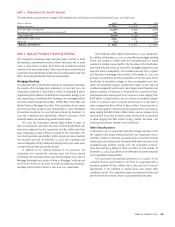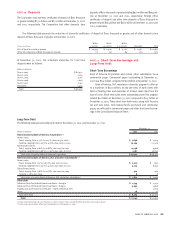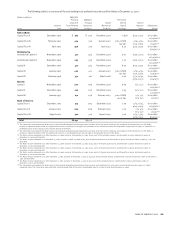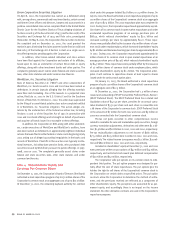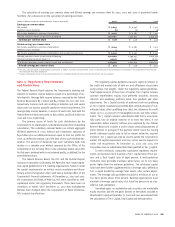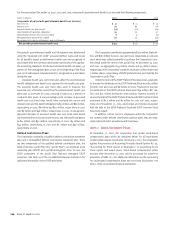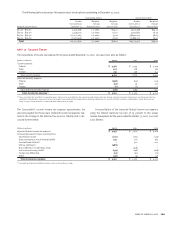Bank of America 2002 Annual Report Download - page 100
Download and view the complete annual report
Please find page 100 of the 2002 Bank of America annual report below. You can navigate through the pages in the report by either clicking on the pages listed below, or by using the keyword search tool below to find specific information within the annual report.
98 BANK OF AMERICA 2002
Enron Corporation Securities Litigation
On April 8, 2002, the Corporation was named as a defendant along
with, among others, commercial and investment banks, certain current
and former Enron officers and directors, lawyers and accountants in a
putative consolidated class action complaint filed in the United States
District Court for the Southern District of Texas alleging violations of
Sections 11 and 15 of the Securities Act of 1933 and Section 10(b) of the
Securities and Exchange Act of 1934 and Rule 10b-5 promulgated
thereunder. On May 8, 2002, the Corporation filed a motion to dismiss
the complaint and on December 20, 2002, the court granted the
motion in part, dismissing the claims asserted under Section 10(b) and
Rule 10b-5 of the Exchange Act. A Section 11 claim on a single securi-
ties offering remains pending against the Corporation.
In addition, other Enron-related individual and class actions
have been filed against the Corporation and certain of its affiliates,
based upon its role as underwriter of certain Enron debt or equity
offerings, along with other investment banks and other parties. The
complaints generally assert claims under federal and state securities
laws, other state statutes and under common law theories.
WorldCom, Inc. Securities Litigation
Banc of America Securities LLC (“BAS”) and other underwriters of
WorldCom, Inc. bonds issued in 2000 and 2001 have been named as
defendants in certain lawsuits alleging that the offering materials
were false and misleading. One of the lawsuits is a purported class
action, filed July 10, 2002 in the U.S. District Court for the Southern
District of New York. On October 11, 2002, the action was superceded
by the filing of a consolidated putative class action complaint entitled
In re WorldCom, Inc. Securities Litigation. This action alleges vio-
lations by the underwriters of the federal securities law, including
Sections 11 and 12 of the Securities Act of 1933 in connection with
2000 and 2001 bond offerings and is brought on behalf of purchasers
and acquirers of bonds issued in or traceable to these offerings.
In addition, the Corporation or BAS, along with other underwrit-
ers, certain executives of WorldCom and WorldCom’s auditors, have
also been named as defendants in approximately eighteen individual
actions that were filed in either federal or state courts beginning in July
2002 arising out of alleged accounting irregularities in the books and
records of WorldCom. Plaintiffs in these actions are typically institu-
tional investors, including state pension funds, who purchased debt
securities issued by WorldCom pursuant to public offerings in 1997,
1998, 2000 or 2001. The complaints generally assert claims under
federal and state securities laws, other state statutes and under
common law theories.
NOTE 14 Shareholders’ Equity and
Earnings Per Common Share
On December 11, 2001, the Corporation’s Board of Directors (the Board)
authorized a stock repurchase program of up to 130 million shares of the
Corporation’s common stock at an aggregate cost of up to $10.0 billion.
At December 31, 2002, the remaining buyback authority for common
stock under this program totaled $2.6 billion, or 24 million shares. On
July 26, 2000, the Board authorized a stock repurchase program of up to
100 million shares of the Corporation’s common stock at an aggregate
cost of up to $7.5 billion. The 2000 repurchase plan was completed in
2002. During 2002, the Corporation repurchased approximately 109 mil-
lion shares of its common stock in open market repurchases and under
accelerated repurchase programs at an average per-share price of
$68.55, which reduced shareholders’ equity by $7.5 billion and
increased earnings per share by approximately $0.22. These repur-
chases were partially offset by the issuance of 50 million shares of com-
mon stock under employee plans, which increased shareholders’ equity
by $2.6 billion and decreased earnings per share by approximately $0.11
in 2002. During 2001, the Corporation repurchased approximately 82
million shares of its common stock in open market repurchases at an
average per-share price of $57.58, which reduced shareholders’ equity
by $4.7 billion. These repurchases were partially offset by the issuance
of 27 million shares of common stock under employee plans, which
increased shareholders’ equity by $1.1 billion. The Corporation antici-
pates it will continue to repurchase shares at least equal to shares
issued under its various stock option plans.
On January 22, 2003, the Board authorized a stock repurchase
program of up to 130 million shares of the Corporation’s common stock
at an aggregate cost of $12.5 billion.
At December 31, 2002, the Corporation had 1.3 million shares
issued and outstanding of ESOP Convertible Preferred Stock, Series C
(ESOP Preferred Stock). The ESOP Preferred Stock has a stated and
liquidation value of $42.50 per share, provides for an annual cumu-
lative dividend of $3.30 per share and each share is convertible into
1.68 shares of the Corporation’s common stock. ESOP Preferred Stock
in the amounts of $7 million for both 2002 and 2001 and $5 million in
2000 was converted into the Corporation’s common stock.
Pre-tax net gains recorded in other comprehensive income
related to available-for-sale and marketable equity securities, foreign
currency translation adjustments, derivatives and other were $2.7 bil-
lion, $1.9 billion and $2.8 billion in 2002, 2001 and 2000, respectively.
Pre-tax reclassification adjustments to net income of $780 million,
$715 million and $105 million were recorded in 2002, 2001 and 2000,
respectively. The related income tax expense was $1.1 billion, $30 mil-
lion and $800 million in 2002, 2001 and 2000, respectively.
Included in shareholders’ equity at December 31, 2002 and 2001
were premiums written on put options of $47 million and $14 million,
respectively, and restricted stock award plan deferred compensation
of $31 million and $52 million, respectively.
The Corporation sells put options on its common stock to inde-
pendent third parties. The put option program was designed to par-
tially offset the cost of share repurchases. The put options give the
holders the right to sell shares of the Corporation’s common stock to
the Corporation on certain dates at specified prices. The put option
contracts allow the Corporation to determine the method of settle-
ment, and the premiums received are reflected as a component of
other shareholders’ equity. The put options are accounted for as per-
manent equity, and accordingly, there is no impact on the income
statement. No other derivative contracts are used in the Corporation’s
repurchase programs.



